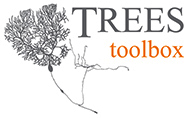
adapted from
PLoS supp. material
by Hermann Cuntz

![]()

For reconstruction purposes or just to compare a tree with its underlying image stack,
load image stacks or single images using the menu.
The TREES internal .stk format stacks are just binary Matlab workspaces
and can be read out in comand line using the matlab „load“ function
(but see also “load_stack”).
In the following we will assume that the first goal is a reconstruction
of a tree present in tiled image stacks.
The stk_ panel is then the first editing panel required.
The image stacks are loaded sequentially and the last stack in the popup control
is the active stack.

This is a good place to mention that „cgui_tree“ stores all information
in a global structure called „cgui“.
To access the data relating to a specific panel (here the stk_ panel)
first „cgui“ is required to be global in the general workspace.
The field name in the structure corresponds to the panel prefix.
For example the 2 matrices containing the image stacks can be read out as:
>> global cgui
>> cgui.stk.M
ans =
[100x100x19 uint8] [100x100x19 uint8]
Two visual representations are offered by the stk_ panel.
One in which for each image stack all three maximum intensity projections are shown.
The other one (the slicer) shows for each image stack
the slice (according to the viewing plane illustrated below using the grid)
which is closest to the vis_ panel slicer values
(but see also “the vis_ panel”).


The active stack (the last one in the popup) can be automatically aligned in 3D
to the stack preceding it, if sufficient image overlap allows it.
A stack‘s coordinates can also be set back to zero with the „0“ control.

The stack coordinates can be set directly in the edit fields.
There, the voxel size can also be set
(here the z-dimension is set to 2µm while x and y are 1 µm each):

entering the edit mode
One of the most sophisticated features of the GUI is that each
of the 5 edit panels (stk_, thr_, skl_, mtr_ and ged_)
has individual edit modes;
some of them even have an alternative edit2 mode
and several corresponding submodes.
The selected active panel for editing is chosen by using the up
and down arrows on the keyboard.
Alternatively, press ctrl [q], [w], [e], [r] or [t]
depending on which of the five panels is needed.
The selected active panel has an increased frame size.
To enter the edit mode press the edit control in the vis_ panel,
press the left arrow key, or press shift [1] (i.e. [!]).

When entering the edit mode the mouse cursor becomes a circle and an edit line appears.
The alternative edit2 mode turns on when the edit mode is on and additionally
the vis_ panel edit2 control is pressed or the right cursor key is pressed
or shift [4] (so [$]). Typically, the edit lines then become yellow.
The keyboard layout can now be extended from the simple axis control
to the full edit control.
In red are keys with additional „ctrl.“ press.
ctrl [z] is an undo function in the tree edit mode.
ctrl [a] and ctrl [s] switch between two trees of the same group (see later).
[z], [Z], [x] and [X] decrease and increase the slicer coordinate respectively.
[c] and [C] are general overloaded cutting keys.
[v] is a preview for a reordering and [V] performs the reordering of nodes
in the skeletonization and tree panel.
[r], [R], [f] and [F] increase and decrease the diameter of tree nodes
or editing elements depending on the active editing panel.


stk_ edit mode
In the stk_ panel edit mode the starting coordinates of image stacks can be set.
The editing depends on the selected view mode,
so at any given point in time it happens only in one plane.
The green edit line indicates which stack is closest.
A double-click activates that stack if it is not active yet.

stk_ edit2 mode
In the stk_ panel edit2 mode, image stack pieces can be cut out according
to a region of interest (ROI). The ROI is planar and is drawn according
to the actual viewing plane. With key-press [c] the brightness values
inside of the ROI throughout the slicer dimension are set to 0.
With [C] the outside of the ROI is treated correspondingly.
The yellow edit line indicates in which image stack the procedure is done:
in this way the same ROI can be used to edit different image stacks separately.
For speed reasons the borders are not kept sharply.
After cutting,
the image stacks are cropped rectangularly off of all zero rows or columns.


This work is licensed under a
Creative Commons Attribution-Noncommercial-Share Alike 3.0 License